The Sustainability Toolbox: Town Center Intersections

This
Town Center Intersection set near San Diego is an excellent example of
vision becoming reality. This layout can support far higher surrounding
densities in a safer and more pedestrian-oriented way than a single
intersection that might have otherwise occured here.
Traditionally, It's Either Form OR Function
All over the nation, planners and residents alike hope to
reinvent languishing suburban retail corridors into sustainable,
livable, transit and pedestrian-oriented "Places." They hope to
carve out a true Town Center within the midst of their stale, Anywhere
USA sprawl. But the exciting Visions created by well-meaning
stakeholders, planners, and architects often bumps up against a hard
reality: The streets in question often carry huge traffic loads and it
is extremely difficult to acquire the space for desired "Complete
Streets."
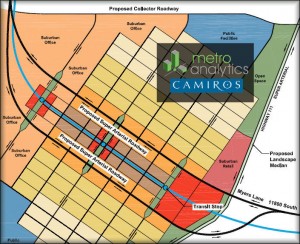
Concept
for future Activity Center, with light rail in the center, high-volume
arterial split into managable streams, and small cross-couplets.
Another sad truth is that even the best Transit Oriented Development
will still generate a lot of vehicle traffic. If the roadways that serve
proposed TOD are too congested, builders and city councils may be too
reluctant to create TOD because it adds traffic to already intolerable
congestion!
And engineers charged with managing the street simply will not accept
form over function. In truth, to be truly livable and to sustain
desired TOD densities, these intersections need to flow well. "Town
Center Intersections" are a hot new design with excellent Place-Making
qualities as well as exceptional ability to move a lot of traffic slowly
but steadily and without congestion through sensitive mixed-use,
multi-modal areas.
How do they work?
The TCI, also known as a Split Intersection, is an intersection
where one or both of the streets involved are a one-way street.
Where two major arterials come together and would have normally formed a
single massive, unwieldy intersection, the Town Center concept instead
separates each arterial into one-way couplets, creating four small,
efficient, easily manageable intersections of one-way streets that merge
back to a two-way street a block or two upstream. A TCI can also
involve a "triplet", which is an alignment between the couplets, perhaps
used as a pedestrian mall or for transit, bikes, and on-street angle
parking.
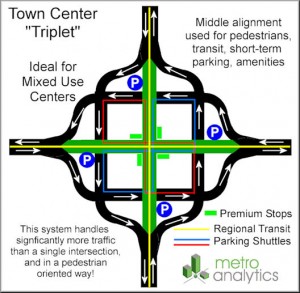
Conceptual
suburban Activity Center, served by regional transit and localized
circulation shuttles to peripheral parking so that the entire inner core
remains accessible by auto, but with very little surface or garage
parking in the core.
Since one-way streets have half the number of lanes, streets are
narrower and safer for pedestrians to cross. Even if speed limits
are reduced when entering the Town Center area, and you might stop at
two signals, average travel times will be faster! Why? One-ways make it
easy to coordinate signals, and you'll probably stop two if not three
times getting through a single overwhelmed intersection.
Hot New Mixed-Use Design, but what makes it Innovative?
San Diego, Las Vegas, Salt Lake City, and others have
incorporated this new design into several mixes use projects - often
paid for by developers. But what makes them Innovative? Our
definition of an Alternative Intersection is a design that successfully
eliminates the need for left-turn arrows. One-way streets allow drivers
both a free-right and a free-left. Simulations comparing the same
high traffic volumes in a single large intersection vs. passing through
four simple intersections reveals that couplets will move more traffic
more quickly, even if there are more signals.
It's Mother Nature's Way!
What if blood in our body's "arterials" tried to flow in both
directions within the same "pipe?" The terms "chaos" and "high blood
pressure" come to mind. It's an absurd way to run a body. The more
dense an urban area becomes, the more chaotic and absurd it is to
operate the urban-organism's circulation system with two-way flow.
Nearly all of our highest density urban areas use one-way circulation.
Hot! - but not really so new
Denver, Portland, Boise, Manhattan - TCI's are "new" in that
they're showing up in hot new developments, but in truth they are the
common thread of our most intense, sustainable Downtown cores since the
auto was first invented.
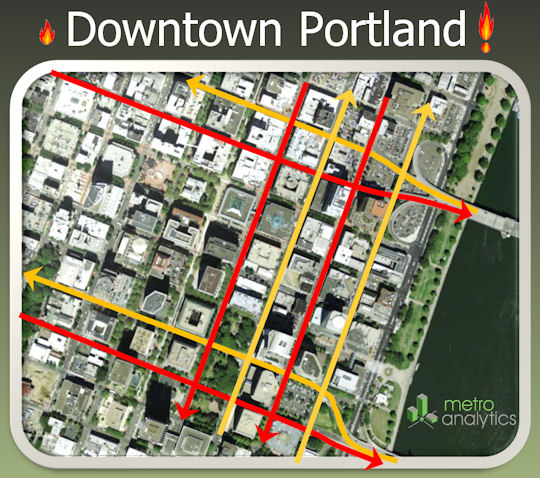
A tight grid of narrow one-way streets is at the foundation of Portland's ability to support quality multi-modal circulation.

Boise
has crossing couplets that form the classic Town Center layout.
Multi-modal circulation is enhanced by this layout, and it also makes it
possible to use triplet alignments between the couplets as pedestrain
areas.
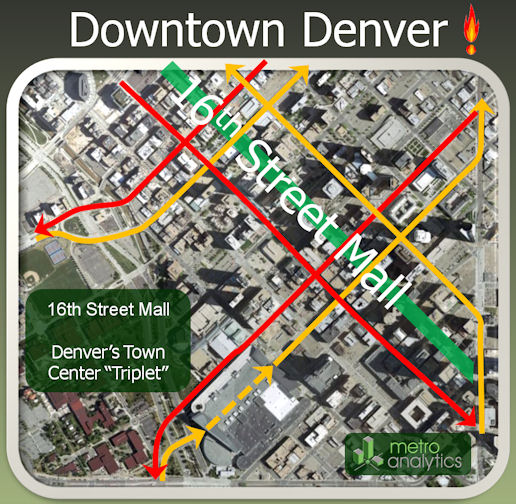
Without
these couplets, it is likely that every street in Downtown Denver would
be in high demand for vehicles, making it far less politically feasible
to ever reclaim 16th Street for their wildly successful pedestrian and
transit mall.
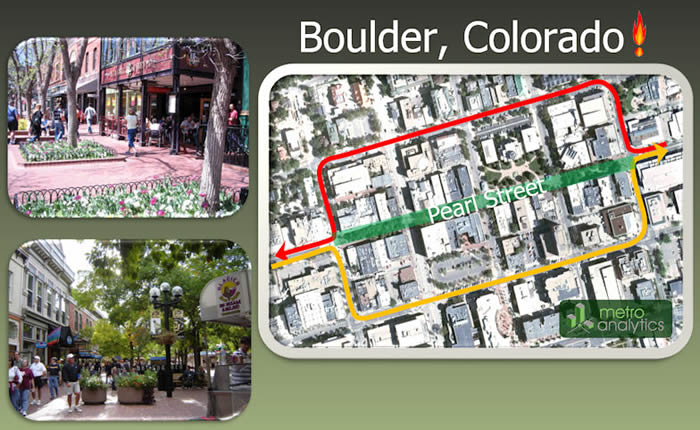
Boulder's Pearl Street area can support high densities largly due to this "Triplet" configuration.
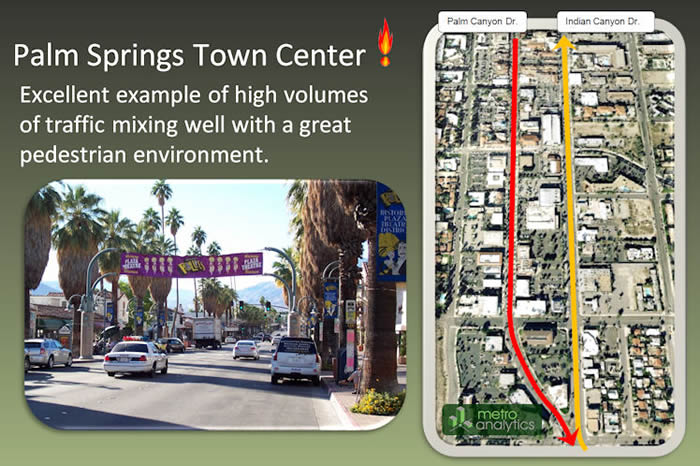
Palm
Springs supports high traffic volumes moving steadily at slow peak
speeds, but good average speeds, through an exceptionally welcoming
pedestrian environment.
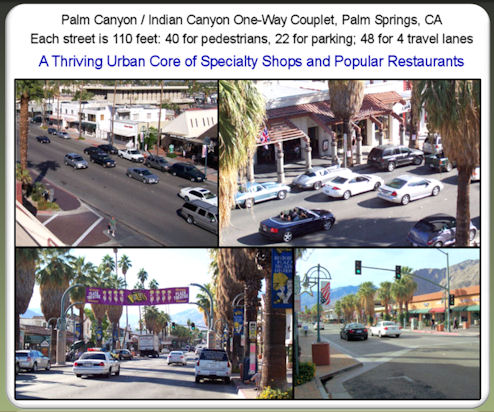
The numbers show that running couplets allows much more right-of-way to be released to uses other than just travel lanes.
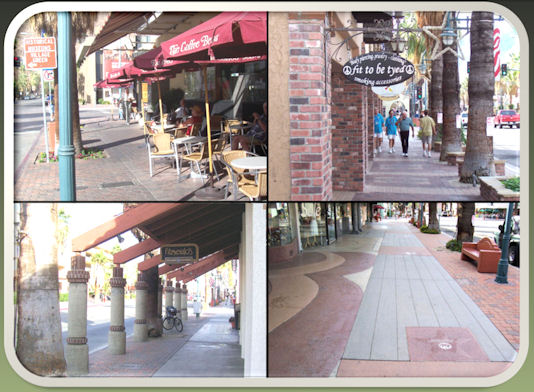
Palm Springs - a quality pedestrian environment, brought to you by the letters T, C, and I!
Aren't One-Ways Killing Downtowns?
Some cities with struggling historic CBDs have been converting
their one-way streets back to two-way, and have been pleased with the
results. But it is wrong to conclude that one-ways were a major
factor in their past struggles. The conversion to two-way is often
accompanied by a streetscape makeover, making it hard to tell if the
rejuvenation came from the aesthetic upgrades or the two-way flow.
Further, if the area has lost traffic and doesn't need one-way
circulation, then why not go back to two-way flow.
One-way streets can be safer and even more pedestrian oriented than
the best two-way streets can be. And the more intense your Activity
Center becomes, the more valuable one-way operation becomes.
More Lessons from Anatomy
If the blood flow to a child's growing limbs is restricted, the
limbs will be stunted. Think for a moment of the life-cycle of our
urban spaces that emerged largely after the invention of the auto. Areas
with the best auto access attract popular businesses. Larger commercial
areas emerge where there is good freeway access.
In a world of cars, the infant urban body first "grows" it's most
intense land uses (single-story businesses) where the cars are. As
that body reaches adolescence, transit-oriented development emerges in
places that historically could serve a lot of cars. And they grow
even faster if those historic arterials happen to be close to a new
freeway. Then as there is market demand to intensify even more,
multi-modal access can play an important roll in intensifying. But like
the arm that will not reach its potential without an expanding blood
supply, our car-oriented urban bodies may take an exceptionally long
time to transition to a transit-oriented blood supply if it cannot also
support more cars during that transition.
And even once it has made that transition, the ability to circulate
huge numbers of vehicles is essential for the most sustainable
environments. In addition to excellent multi-modal usage, urban centers
in San Francisco, Portland, New York, and almost everywhere have a tight
grid of one-way streets. Streets don't seem overwhelmed with vehicles,
but there are so many through streets that in aggregate the area
supports huge numbers of vehicles!
In other words, if any modern Greenfield or low-density area
envisions its future with a lot of TOD, that same area has got to find a
way to support a lot of cars, or the growth will happen at glacial
speed even if it is served by high-capacity transit! It is true that the
onset of gridlock will get more people onto dedicated transitways, but
it will also discourage further development, which ultimately sees fewer
people on transit. Perhaps we sprawl outward in part because
gridlock makes it too challenging to grow inward!
The Town Center Intersection and other Alternative Intersections are
excellent strategies for creating the high-capacity vehicular
circulation that is an essential ingredient for fostering TOD.
Advantages of TCIs
- Up to 50% more capacity!
- Level of Service B-D rather than E-F
- Drive slower, travel faster
- Narrower, Complete Streets
- Safer for both autos and pedestrians
- Supports very high densities
- "Free" when integrated by developers
- Easy access to retail
- Expands grid within Activity Center
- Better traffic progression
Disadvantages
- Confusion in places with few one-ways
- Challenge convincing retail and other stakeholder that this is good
- Minor out of direction travel
TCIs are "Alternative Intersections"
Town Center Intersections, along with several cousins such as
Quadrant Intersections, Through-Turn Intersections, Continuous Flow
Intersection, and others are among a series of concepts collectively
known as Alternative Intersections, Alternative Intersections, or even
Unconventional Intersections. The key trait that links all Innovative
Intersections is that they successfully eliminate the "left-turn arrow"
phase, which otherwise reduces intersection efficiency considerably.
|

